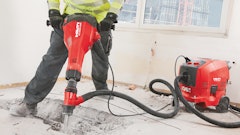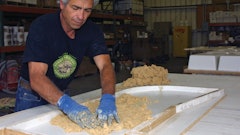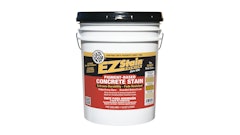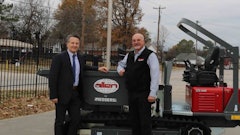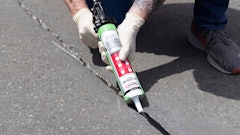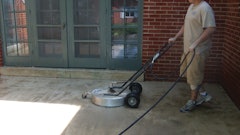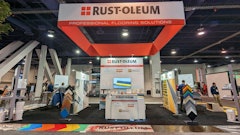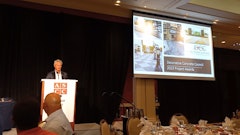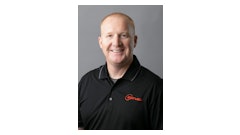As an independent consultant most of my firm’s time is spent assisting retailers with managing their flooring programs. I regularly assist with specifications and quality control of the installation, but maintenance by far is where I spend the majority of my time. Polished concrete in its current form has been around for about 15 years in the U.S. For a long time, the process of mechanically polishing concrete was sold to consumers as a “maintenance free” floor. To my knowledge, there is nothing in the world that is maintenance free.
Generally, contractors and installers do not really have a good understanding of how maintenance fits into their work. When a retailer is considering polished concrete flooring, maintenance is generally the driving factor.
VCT vs. polished concrete
In the retail world, VCT (Vinyl Composition Tile) remains the dominant floor covering in use. A VCT floor costs $3.00 per foot to install on average across the country. Standard VCT has to be waxed, as the finish provided by the factory does not last long as the wearable surface. Maintenance for VCT averages $2.00 per foot per year. The cost of maintenance includes scrubbing the floor nightly, buffing the floor regularly to remove scuffs from foot traffic and regular strip and wax services.
Polished concrete has an average install cost of $5.00 per foot in a remodel environment. If installed at the time of a remodel (versus new construction which generally has a cheaper price) polished concrete costs $2.00 more per foot to install, but a good maintenance program for polished concrete has an average cost of $1.00 per foot per year. In two years, the difference of the install costs has been recovered. From that point forward, the floor maintenance is actually saving money for the customer.
Generally, VCT lasts seven to ten years before it deteriorates to the point where it needs to be replaced. Removal of VCT averages $1.50 per square foot. Add removal to the install cost of $3.00 and you get a removal and replacement cost of $4.50 per foot.
Polished concrete never has to be completely redone and there is no removal. The average refurbish price for a polished concrete floor is $1.50 per foot. That is a $3.00 per foot savings every ten years on top of the $1.00 per foot per year savings of the standard maintenance.
To give you a real world comparison let’s look at a grocery store. The average store has 45,000 square feet of sales floor, of which 35,000 square feet is exposed (not under shelving or displays). This store will spend $135,000 ($3.00 per foot by 45,000 feet) initially to install VCT and then over the next ten years they will spend a total of $700,000 (exposed area of 35,000 feet by $2.00 per foot) on maintenance. When it is time to replace their VCT they will spend another $202,500 ($4.50 by 45,000 feet) for removal and replacement. Therefore, their total cost of their VCT floor is $1,037,500 over ten years.
A polished concrete floor would cost them $225,000 (45,000 feet by $5.00 per foot) to install then over ten years they will spend $350,000 (35,000 exposed floor space by $1.00 per foot per year)to maintain their floors. At ten years, they need to refurbish the floor so they will spend another $67,500 (45,000 feet by $1.50 per foot) to bring the floor back to where it was at construction. The total ten-year cost is $642,500. The polished concrete saved the store $395,000 over ten years. That is called ROI or Return on Investment. This is the single largest driver of polished concrete flooring.
This model only works if the polished concrete floor is mechanically finished well so that it can be maintained properly. I recently reviewed thirty stores for one retailer. Of the stores I looked at, approximately two-thirds were not mechanically finished well enough to be maintained using normal procedures. The floors looked dull, held dirt and grime, and in some cases had safety issues as a result of workmanship. As an industry, if we want to survive, we cannot turn floors like this over to the customer. When we do, the operations groups (which is the real power) get frustrated and start pushing to go away from polished concrete. If the price point that the customer is willing to pay does not allow you to correctly install a “fully processed seven to nine step polished and ground system”, there are several options in my opinion. Explaining the ROI to the customer and showing the value of your full process is one option.
A second option is to CLEARLY lay out your plans for the lower cost system and talk about the life cycle cost of going the cheaper route.
The third option is to walk away from that project. Believe me, I know it is hard to walk away from potential revenue, but if a project is not properly done the resulting loss of revenue on multiple future projects will not be sustainable for your company or the industry in the long run.
Over the last few years, I have watched this scenario play out with several retailers. Instead of adding millions of square feet of polished concrete into the available jobs, retailers do a few floors, realize that they are not getting the ROI out of them and go back to VCT. Do not kid yourself into thinking that the look of polished concrete sells itself. VCT is much easier to control the look, especially in a remodel situation. The benefit of concrete flooring is in the savings at the bottom of the expense line. The flooring maintenance is intimately tied to new projects being constructed.
Long-term maintenance
In order for the polished concrete industry to survive and flourish, long-term maintenance has to take some huge steps towards standardization and ease of use. The best maintenance products for polished concrete floors are made today by chemical companies that are already in the concrete business. Some of the larger construction chemical companies make cleaners that have densifier and stain protection in them. These cleaners do not etch the surface of the concrete, but still do a great job of removing grease. These are extremely important when taking care of a polished concrete floor, especially in retail environments.
Currently these chemicals are available either direct from the manufacturer or through construction supply companies. The problem is that janitorial contractors do not generally shop at construction suppliers, instead they shop at janitorial suppliers and they do not try to find a manufacturer to purchase from directly. In the construction industry, contractors find suppliers that they like and buy from them regularly. Janitorial contractors likewise follow the same process for purchasing. They have suppliers that they have been buying from for a long time and changing is difficult. In order for the polished concrete maintenance to succeed, one of two things needs to happen concerning the chemical supply chain. Either current janitorial chemical manufacturer's need to make cleaners that are more effective at removing grease, maintaining shine and replenishing stain protection or polished concrete chemical manufacturers need to do a MUCH better job of placing their products in janitorial supply companies so that these chemicals are more readily available to janitorial contractors.
Current chemical manufacturers will need to consider the packaging of their cleaning products. Companies that make janitorial cleaners of all types figured out long ago that if too much or too little of their product is used, the results change dramatically. Most of the larger manufacturers offer “portion control” systems to make sure that the correct amount of chemical is used. Only one current polished concrete chemical manufacturer has addressed the issue that I am aware of. As it is not reasonable to install new portion control systems in each store, chemical is being packaged in single use packets with pre-measured amounts. I know of one other manufacturer that is working towards a better system as well. The standard delivery method is five-gallon buckets of product. It is impossible to properly measure the correct amount of cleaner using a five-gallon bucket and pouring cleaner into an auto scrubber or mop bucket. If improper amounts of cleaner are used it will affect the life cycle cost of the floor in multiple ways and erode some of the advantages that polished concrete has over other flooring types.
Contractor's need to discuss maintenance
As a contractor, when you finish a project, one of the most important things that you can do is to discuss maintenance with your customer. Do not settle for having a short conversation. Invest some time and come up with a simple maintenance document that you can email to everyone who is involved with the project. This includes owners, contractors and architects.
Recommend cleaners that match up with your densifier and stain protection so that a single system can be implemented throughout. The customer will appreciate this tremendously.
Set up a short training class for your customer as well. By doing this, at least if they use cleaners that are not recommended, you could remind them and show them what was provided when the project was completed.
Turning over a floor to a customer without a maintenance program is like building a car and selling it without a manual. You can build a great car, but if the owner does not change the oil, use the right fuel and perform normal routine maintenance the car is not going to stay operational for very long. A polished concrete floor is the same way. Maintenance is the single biggest reason that projects are available for construction, so take the time to do your part in assisting the customers with maintenance. Whether you are a customer, general contractor, contractor, manufacturer or supplier, there are key things that you can do to help maintenance move forward in this industry.
Ed. Note: David Stephenson is president of Polished Concrete Consultants, LLC. He can be reached at [email protected].




